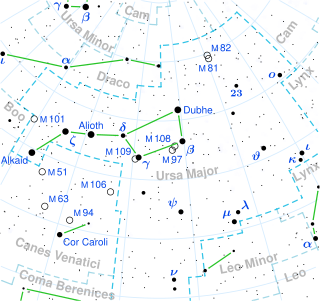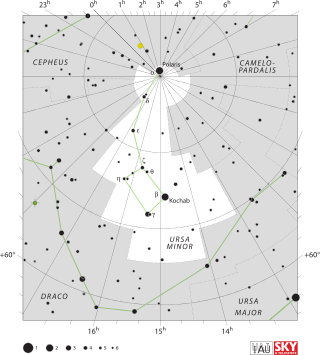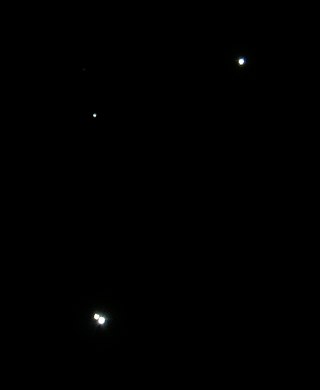
Alioth, also called Epsilon Ursae Majoris, is a star in the northern constellation of Ursa Major. The designation is Latinised from ε Ursae Majoris and abbreviated Epsilon UMa or ε UMa. Despite being designated "ε" (epsilon), it is the brightest star in the constellation and at magnitude 1.77 is the thirty-third brightest star in the sky.

Ursa Major is a constellation in the northern sky, whose associated mythology likely dates back into prehistory. Its Latin name means "greater bear", referring to and contrasting it with nearby Ursa Minor, the lesser bear. In antiquity, it was one of the original 48 constellations listed by Ptolemy in the 2nd century AD, drawing on earlier works by Greek, Egyptian, Babylonian, and Assyrian astronomers. Today it is the third largest of the 88 modern constellations.

Ursa Minor, also known as the Little Bear, is a constellation located in the far northern sky. As with the Great Bear, the tail of the Little Bear may also be seen as the handle of a ladle, hence the North American name, Little Dipper: seven stars with four in its bowl like its partner the Big Dipper. Ursa Minor was one of the 48 constellations listed by the 2nd-century astronomer Ptolemy, and remains one of the 88 modern constellations. Ursa Minor has traditionally been important for navigation, particularly by mariners, because of Polaris being the north pole star.

Kochab, Bayer designation Beta Ursae Minoris, is the brightest star in the bowl of the Little Dipper asterism, and only slightly fainter than Polaris, the northern pole star and brightest star in Ursa Minor. Kochab is 16 degrees from Polaris and has an apparent visual magnitude of 2.08. The distance to this star from the Sun can be deduced from the parallax measurements made during the Hipparcos mission, yielding a value of 130.9 light-years.

Phecda, also called Gamma Ursae Majoris, is a star in the constellation of Ursa Major. Since 1943, the spectrum of this star has served as one of the stable anchor points by which other stars are classified. Based upon parallax measurements with the Hipparcos astrometry satellite, it is located at distance of around 83.2 light-years from the Sun.

An asterism is an observed pattern or group of stars in the sky. Asterisms can be any identified pattern or group of stars, and therefore are a more general concept than the 88 formally defined constellations. Constellations are based on asterisms, but unlike asterisms, constellations outline and today completely divide the sky and all its celestial objects into regions around their central asterisms. For example, the asterism known as the Big Dipper comprises the seven brightest stars in the constellation Ursa Major. Another is the asterism of the Southern Cross, within the constellation of Crux.

Dubhe, also called Alpha Ursae Majoris, Latinised from α Ursae Majoris, is, despite being designated "α" (alpha), the second-brightest object in the northern constellation of Ursa Major. This prominent asterism is known as the Big Dipper, the Plough, and the Great Bear. Alpha Ursae Majoris is the northern of the 'pointers', the second being Beta Ursae Majoris, or 'Merak' – this pair of stars point towards Polaris, the North Star.

Merak, also called Beta Ursae Majoris, is a star in the northern constellation of Ursa Major.

Alkaid, also called Eta Ursae Majoris, is a star in the constellation of Ursa Major. It is the most eastern (leftmost) star in the Big Dipper asterism. However, unlike most stars of the Big Dipper, it is not a member of the Ursa Major moving group. With an apparent visual magnitude of +1.86, it is the third-brightest star in the constellation and one of the brightest stars in the night sky.

Alcor is a binary star system in the constellation of Ursa Major. It is the fainter companion of Mizar, the two stars forming a naked eye double in the handle of the Big Dipper asterism in Ursa Major. The two both lie about 83 light-years away from the Sun, as measured by the Hipparcos astrometry satellite.

Mizar is a second-magnitude star in the handle of the Big Dipper asterism in the constellation of Ursa Major. It has the Bayer designation ζ Ursae Majoris. It forms a well-known naked eye double star with the fainter star Alcor, and is itself a quadruple star system. The Mizar and Alcor system lies about 83 light-years away from the Sun, as measured by the Hipparcos astrometry satellite, and is part of the Ursa Major Moving Group.
Megrez, also called Delta Ursae Majoris, is a star in the northern constellation of Ursa Major. With an apparent magnitude of +3.3, it is the dimmest of the seven stars in the Big Dipper asterism. Parallax measurements yield a distance estimate of 80.5 light-years from the Sun.
Mu Ursae Majoris, formally named Tania Australis, is a binary star in the constellation of Ursa Major. An apparent visual magnitude of +3.06 places it among the brighter members of the constellation. Parallax measurements give an estimated distance of roughly 230 light-years from the Sun, with a margin of error of 4%.
Iota Ursae Majoris, also named Talitha, is a star system in the northern circumpolar constellation of Ursa Major. It has an apparent visual magnitude of 3.14, making it visible to the naked eye and placing it among the brighter members of this constellation. Based upon parallax measurements, it is located at a distance of 47.3 light-years from the Sun.
Xi Ursae Majoris is a star system in the constellation of Ursa Major. It has the traditional name Alula Australis; Xi Ursae Majoris is the Bayer designation, which is Latinised from ξ Ursae Majoris and abbreviated Xi UMa or ξ UMa. It was the first visual double star for which an orbit was calculated, when it was computed by Félix Savary in 1828. It is also a variable star with a small amplitude. Xi Ursae Majoris is found in the left hind paw of the Great Bear.

Zeta Ursae Minoris, which is Latinized from ζ Ursae Minoris, is a single star in the northern circumpolar constellation of Ursa Minor, forming the northernmost part of the bowl in this "little dipper" asterism. The star has a white hue and is faintly visible to the naked eye with an apparent visual magnitude of +4.28. It is located at a distance of approximately 369 light-years from the Sun based on parallax, but is drifting further closer with a radial velocity of about –13 km/s.

The Saptarshi are the seven seers of ancient India who are extolled in the Vedas, and other Hindu literature such as the "Skanda Purana". The Vedic Samhitas never enumerate these rishis by name, although later Vedic texts such as the Brahmanas and Upanisads do so.

The Big Dipper or the plough is a large asterism consisting of seven bright stars of the constellation Ursa Major; six of them are of second magnitude and one, Megrez (δ), of third magnitude. Four define a "bowl" or "body" and three define a "handle" or "head". It is recognized as a distinct grouping in many cultures. The North Star (Polaris), the current northern pole star and the tip of the handle of the Little Dipper, can be located by extending an imaginary line through the front two stars of the asterism, Merak (β) and Dubhe (α). This makes it useful in celestial navigation.
Sigma2 Ursae Majoris is a binary star in the constellation of Ursa Major. Parallax measurements made by the Hipparcos spacecraft put it at a distance of about 66.5 light years from Earth, making this a fairly nearby system. The primary component has an apparent magnitude of about 4.8, meaning it can be seen with the naked eye (see Bortle scale).

Sidus Ludoviciana, also known as HD 116798 is an 8th-magnitude giant star in the asterism of the Big Dipper in the constellation Ursa Major, halfway between Mizar and Alcor. It was discovered on 2 December 1722 by Johann Georg Liebknecht, who mistook it for a planet and named it after Louis V, Landgrave of Hesse-Darmstadt. A line-of-sight companion with Mizar and Alcor, it is roughly four times more distant. It has the spectral type A8/F0 III. That spectral class suggests it is a giant star, but evolutionary models place it on the main sequence.








